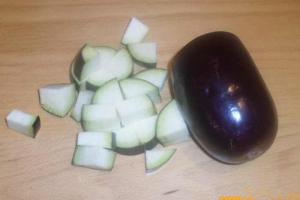Faded and cracked paint on wooden frame, doors, log house and any other cleaned wooden surface, which is present in the house, carries a certain charm of antiquity and comfort. But time and weather conditions have not been canceled, and the coating begins to crumble in pieces to the ground. It's time to go to the construction market for a new composition and update appearance ancient wood. But first old paint must be removed without damaging the tree. This article is about how to remove old paint from wood.
Before you pick up a hair dryer, a brush with a chemical remover and read about how to remove old paint from a wooden surface, you need to find out about the type of wood with which you will be working. Some types of wood require more care than others. For good result On any tree, you must follow the technology - correctly use products to remove decorative coatings.
It would be a good idea to find out about the age of the wood, its operating conditions, climatic conditions, as well as other factors that have or previously had an impact on painted wood.

Wood can last for decades only if properly constant care. In some cases, wood exposed from the old paint layer will require treatment with protective agents, otherwise the new coating will not last very long.
Preparing tools
Prepare your tools in advance. To remove you will need:
- spatula or scraper;
- industrial hair dryer with temperature control;
- drill or drill with replaceable attachments;
- grinder or grinder;
- chemical remover;
- a rag to wipe off excess paint;
- respirator, gloves and safety glasses.

What can be processed?
See below for which products can be subjected to the paint removal procedure:
- internal and external wooden fittings;
- exterior and interior doors and door frames;
- wooden stair railings;
- window frames and window sills;
- wooden floor boards;
- parquet;
- wooden baseboards.

Paint removal methods
All efforts to remove old coating from wooden surfaces come down to four main approaches. How to remove paint from window frames, doors, carved elements, what to wash off and erase acrylic paint one of the selected methods, you can find out below:
- Removing old paint from wood surfaces is much easier with this method. The coating, which is already cracked and easily flies off, is scraped off with a spatula or a special metal scraper. Areas that are not easily removed by hand are finished using power tools. Mechanically, you can easily remove old paint from doors, windows, window sills and other surfaces suitable for treatment.

- Sandblasting with fine abrasive. A stream of air and fine-grained sand (or soda) crushes and knocks down pieces of coating from the treated area of the tree. This is not the most used or well-known method. It requires professional and expensive equipment, so this work is performed only by specialists. This is the most expensive, but at the same time quick way removing old paint. With the correct abrasive grain size and air pressure, the wood does not suffer any damage.

- Thermal method. The paint is heated with an industrial hair dryer and becomes very soft, after which it can be easily removed with a spatula. If it's too much heat, then the structure of the tree can be damaged. Wood different breeds has its own limits of thermal influence. This effective method removal for almost any, even the oldest paint. Even a person without experience can remove old paint from a wooden surface with a hairdryer. The melted coating is easily pryed off and removed with a spatula.

- Chemical method. A layer of a chemical reagent is applied to the paint, which reacts and dissolves it. Chemical solvents weaken the bond of paint molecules, and it easily comes off the wooden surface. Many people call this method the most effective. Reagents must be selected individually for different types of wood.

How to remove old paint from window frames using this method? Using available tools, you can quickly remove old paint from wood down to the very base. Remove loose coating with a scraper or spatula. The movements should be quite strong and sharp, but you need to remember that sharp corners spatula may leave marks on the surface of the wood.
The color does not require moistening or other preparation and is removed immediately. This way you can quickly remove old paint from a wooden door or other flat wooden surface. simple tools, which are found in almost every closet or garage.
Next, in those places where the paint holds more firmly, an electric tool is used. The door from old paint, which was applied in more than one layer, can be quickly cleaned by sanding. This can also be used to clean wooden windows.
The abrasive paper should not be rougher than 100, otherwise it will damage the wood.

Using smooth movements, the residue is cleaned from the tree. If the layer is thin enough, then you don’t have to clean the paint with power tools. Grinder suitable for flat wooden doors without threaded elements.

Drill attachments in the form metal brushes should only be taken in as a last resort, if there is nothing else at hand and the work needs to be done urgently. Rough wire will scratch the wood and there is a possibility that it will need to be primed and sanded before painting, which will entail additional time and money costs.
It is better to first test any method of removing paint on an unnecessary or hidden piece of painted wood, and then you can take on the entire main volume.

In the video: removing old paint from a wooden window frame.
Application of sandblasting
Removing paint from a wooden surface is easy if you use sandblasting. The air stream from the compressor mixes with small solid particles, and then breaks the old paint into dust.
This method will be especially effective if the coating layer is quite thick and you need to remove it quickly enough.

Abrasive particles that are too coarse will begin to break up the wood, so often the abrasive is taken smaller. It could be river sand or baking soda. For removing old paint from wood, which does not have a very thick layer, sandblasting is suitable not only because of the speed of work. Removing a thin layer will be beneficial from an economic point of view.
With this removal method, it is very important to select the correct abrasive powder supply and compressor pressure settings. Then the coating will fly off instantly, and the tree will remain unharmed.

This method is effective, but it is not economical: treating the entire house can cost a pretty penny. A person who has little experience in such work can damage the wood. Therefore, you need to read the reviews in advance about the work of the company that provides this type of service. Removing paint using this method occurs carefully, without much physical effort.
Heat treatment
The old paint is heated with a hair dryer until it becomes soft and pliable. The softened paint must be cleaned off with a spatula. The operation is repeated until the old paint layer is completely removed. The temperature and heating time will directly depend on the thickness of the layer, as well as the composition of the old coating. This method can be called the fastest of the most effective methods that are available in living conditions. There is no need to buy a hairdryer; you can rent one.
The point of thermal removal is not to burn or completely melt the paint. It should lose molecular cohesion but retain sufficient viscosity for ease of removal.

The painted surface must be heated constantly, evenly, because the color quickly sets and then hardens again. Remove the old paint completely, along with the old primer - the wood will remain in the same form as it was before the first painting.
A hairdryer is unlikely to damage a painted wooden surface, and it is almost impossible to cause a fire. Such cases are extremely rare. This can happen if the wood is saturated with some kind of flammable compound (for example, gasoline or kerosene was spilled on the floor). Therefore, if you choose how to remove old paint and preserve wood, then a hair dryer is perfect for such requests.

Chemical method
If you don’t know what and how to clean a window from old paint, then the chemical method, according to many builders, is the most effective method to get rid of the old coating. The surface is covered with a layer of solvent using a brush, roller or aerosol can.
After some time, the coating swells, begins to bubble, and wrinkle. This means I went chemical reaction. Remove the coating according to the instructions on the back of the paint remover. Dissolved paint is easy to clean; it is washed off or removed with a spatula.
Almost all types of coating are amenable to chemical solvents. Removers do not cause any harm to wood. Chemically cleaned wood can be immediately prepared for painting or varnishing.

Things will go faster if there are cracks on the surface. The washer will quickly fill them, and the reaction will begin on both sides at once, which will significantly speed up all the work. But even for paint without visible defects, chemicals are used successfully.
If the wooden surface is located indoors, then good ventilation must be ensured. Be sure to use protective equipment. Chemical paint removers are toxic and can cause irritation, burns, and poisoning.
Some old paints contain lead, which can create toxic volatile compounds when the paint is chemically removed. It is recommended to use personal respiratory protection equipment.

Homemade chemical remover
How to remove old paint from window frames? If there are no solvents at hand, then removing paint from wood carried out using a self-made product. To do this, a chemical paint remover is made from caustic soda. The recipe is below.
You will need:
- water - 4.5 l;
- slaked lime - 0.9 kg;
- soda ash - 1 kg;
- chalk (preferably) - 1 kg.
Soda is dissolved in water and heated to 60 degrees. Lime is gradually poured into the solution, followed by chalk, if available. The finished solution is immediately ready for use. According to reviews, it is quite effective; it will wash away a medium-thick layer of coating from wood so that it is completely clean. Now you know how to wash off the old coating, how to clean the door and any wooden surface.
How to properly remove old paint (2 videos)
Application of different methods (30 photos)
























Most finishing craftsmen agree that before repainting wooden objects and facades, the old decorative layer must be completely removed. But how to remove this “makeup”? And is it possible to do without such a labor-intensive and tedious procedure?
If the paint was applied once and adheres well, it does not need to be removed. It is enough to walk through fine-grained sandpaper to remove noticeable unevenness. But in the case when painting was done many times, all decorative layers will have to be removed, otherwise new paint will fall off along with the old one.
There are several ways to remove old paint, and we will look at the main ones.
Mechanical method
The simplest and affordable way paint removal - mechanical. This will require several sheets of sandpaper and quite a lot of patience. First, the surface is treated with large, rough sandpaper, removing the decorative layer. And then gradually bring the surface to smoothness, cleaning with increasingly fine abrasive.
Working with sandpaper, you can wrap it around a small wooden block, which is comfortable to hold in your hand. This will make your work much easier
Manually removing old paint is an extremely long and tedious process. It can be easily speeded up by using a grinder or drill with appropriate attachments. A flap sanding disc can easily handle a couple of layers of old paint. But in particularly advanced cases, you will need a brush with metal bristles.
The instrumental method of removing paint has two significant disadvantages. The first is education. deep scratches that have to be sanded or filled with putty. The second is the dust generated during work. It is very important to work in a respirator and safety glasses so as not to harm your health.
Deserves special mention method sandblasting . For this you need special machine, which delivers a stream of air or water mixed with fine sand. The grains of sand effectively and at the same time quite gently remove the old paint layer.
The disadvantage of this method is obvious - the need to use special equipment and attract qualified specialists. But if you need to clean large surfaces (for example, facades) of old paint, the sandblasting method will probably be the most profitable, as it will save a lot of precious time.
Thermal method
When removing paints that form a dense thick film on the surface, heating works effectively. For example, you can blow the surface with a hair dryer, and then scrape off the melted paint with a knife or spatula.
If you don’t have a hair dryer at hand, the way out is... an ordinary household iron. The wooden surface is covered with a sheet aluminum foil and iron until the paint begins to peel off. Certainly, big wall You can’t clean it this way, but for doors, window frames or furniture this method is quite acceptable.
But to influence the paint with a blowtorch or gas burner, as some experts advise, it’s probably not worth it. First of all, for reasons fire safety. But there is another, quite significant reason. At best, an open fire will dry out the wood, which can lead to cracking. At worst, it will simply burn, making further coloring impossible. However, burning wood in itself is decorative processing, which we wrote about in the article “Burn it with fire.”
When heated, some types of wood release resin, which settles on the surface in the form of a film, significantly complicating further painting.
Chemical method
Theoretically, you can use acetone, but as practice shows, it is powerless against a thick, dense layer of paint. A much stronger solvent is needed. For example, a 10-12% caustic soda solution, thickened with acid-resistant clay powder or simple oatmeal. The paste obtained in this way is applied to the surface with a brush, left for 10-20 minutes, and when the paint begins to bubble, remove it with a spatula or a stiff brush. Upon completion, rinse the surface thoroughly with water to remove any remaining caustic paste.
The described method is quite effective, but it should be noted that caustic soda is a very aggressive chemical reagent. When working with it, you must use protective gloves and a respirator. If paint removal occurs inside the house, it is very important to ventilate the area well immediately after completion. If the composition gets on the skin, it must be washed off with plenty of water.
Also, to remove paint, use gasoline, a mixture of turpentine and grated laundry soap and a number of other homemade recipes. And for those who don’t want to become an “alchemist”, many special flushes have been developed j. There are products for oil coatings, nitro paints, enamels, etc. We emphasize that the vast majority of them are flammable and toxic, and therefore require the strictest adherence to safety measures. Conscientious manufacturers attach to their product detailed instructions, where all necessary protective measures are indicated.
High quality, effective means paint removal can cost as much as the paint itself, and sometimes more
To wrap up the topic, let’s add that when starting to remove paint, it will be useful to stock up on wood bleach. The fact is that under the old decorative layer unpleasant surprises are often discovered - darkening from rot and fungus. Theoretically, you can lighten the surface with a chlorine solution, but it would be wiser not to “chemically” at home, but to purchase a ready-made preparation intended for these purposes. Almost all large companies that produce paints, antiseptics and fire retardants for wood offer such products.
The renewed surface is washed, dried, primed and painted again. New decorative composition must be the same type as the previous one, although there are exceptions to this rule. For example, oil paint can be used with either oil or acrylic paint.
Go to our channel so you don't miss anything!

Depending on the chosen cleaning method, you will need:
- metal spatula, chisel or special scraper;
- hair dryer for construction work;
- electric drill with attachment;
- grinder with a disc for cleaning and grinding;
- paint remover;
- personal protective equipment in the form of gloves and goggles.
Depending on the area of the surface being processed, you will definitely need some of the listed tools and materials.
Basic removal methods
Before removing old paint from wood, you need to familiarize yourself with cleaning the surface and select best option for your wood product.
Today the most common are:
- chemical method using special reagents;
- thermal method using high temperatures;
- mechanical using mechanical action on the surface.
Chemical removal method
For this purpose, special solutions are used that contain chemical reagents to destroy the paint layer on the surface.

The reagents are applied to the product to be treated using a regular brush or fine-pile roller. After this, you need to wait the set time for the chemical to do its job and finish painting with a spatula, without applying any force.
This cleaning option is considered the fastest and does not require physical exertion, however, chemical substances have pungent odors and when working with them toxic substances are released. Before using them, it is necessary to ventilate the room and use a respirator to protect the respiratory tract. It is also necessary to use protective gloves, as contact of this substance with the skin can cause chemical burns. It is worth noting that they are quite expensive and the waste material requires special disposal.
You can prepare a composition for destroying old paint and varnish yourself. For this, a mixture of lime and potassium carbonate is used, however, this product is much less effective.
Thermal removal method
Everyone has long known about old coatings using a conventional hair dryer, since this option is the cheapest and very effective.
It is enough to simply heat the painted surface to the desired state, after which the paint can be easily removed with a regular scraper, spatula or chisel. If you don’t have a hair dryer and don’t have the necessary finances to buy a new one, you can use regular metal foil. Place the foil against the surface and heat it with an iron, then old layer.
Before removing old paint from wood using a thermal method, it is worth considering that the treated coating can ignite if it is overheated, so take care of the possibility of extinguishing in advance. It is also not recommended to use a hair dryer in or plastic products, since the temperature can damage them.
Mechanical cleaning method
If you use thermal or chemical methods there is no possibility, then you can use it mechanical cleaning. This is effective when working over large areas, because through the use of various electrical devices the process is significantly accelerated. Most often, a grinder with a special circle is used, on which sandpaper or any other similar material with an abrasive is placed.

When using an angle grinder or electric drill Paint removal occurs dry, which is accompanied by a large amount of dust. When working, be sure to use protective gloves, goggles and a respirator. Before removing paint from wood mechanically, it is necessary to take into account the type of wood, since the use of abrasive materials can cause damage to the surface being treated if not making the right choice sandpaper.
If the sandpaper has a coarse grain, then when processing with great pressure on the surface, depressions may appear in the wood. If this happens, change the sandpaper to finer sandpaper or do not apply much force when processing. In case of depressions, the surface must be puttied and treated with primer before painting.
Some craftsmen use a thermal method to remove old coating by exposing the treated area of the product to open fire. Using this method is highly discouraged due to the increased risk of possible fire.

In addition, when processing products from various types of wood using this method, the material dries out and its internal structure is damaged, which significantly reduces the strength of the product and its service life.
Some such processing may release resins that are easily flammable or create a film on the product. This film will significantly reduce adhesion, and may even prevent you from applying a new layer to the surface.
When choosing methods for removing old coating, the main thing is to follow the rules of personal safety, use protective equipment and follow safety precautions when working with electrical appliances.
One of the most effective ways to remove old paint from wood is to use a chemical stripper. The cleaning agent reacts with the paint material, causing the coating to soften and foam. The main advantage of chemical removers over other methods (mechanical, thermal) is that their action is more gentle on wood.

Types of washes
All types of washes are divided into two large groups: universal and specialized. Universal compositions are designed to remove any paints and varnishes from wooden surfaces. They are capable of dissolving paints and varnishes both water-based and those containing organic solvents.
The purpose of specialized removers is to soften only certain types of paints. For example, there are separate remover compositions for removing textured, oil-based and other types of paintwork materials. Specialized removers are considered more effective, since their development takes into account the characteristics of specific types of dyes. At the same time, specialized formulations are more expensive.
Removers are produced in the form of liquids, jelly and dry substances for further dissolution. When choosing a cleaning composition, it is necessary to proceed from the circumstances: for example, a jelly-like paste adheres well to wood, and therefore will not drain from vertical surfaces.

But liquid wash compositions - the best choice, if you have to clean a surface on which there are small parts or fine thread. If we are talking about expensive furniture (especially those covered with veneer), you need to choose a liquid that can be removed with white spirit, since if this is not done in time, the wood fibers of the product will swell.
Before purchasing a remover, it is recommended to carefully read the instructions (usually they are written directly on the packaging) or consult with a sales consultant. It should also be taken into account that not every preparation is suitable for working with wood. Therefore, it is important that the cleaning composition is intended specifically (or including) for wooden products.
Instructions for using the remover
The work consists of two stages: preparation and application of the wash.
Preparatory activities
Before you begin removing paint, you need to prepare the surface. To do this you will need to do the following:
- We remove dust and dirt from the surface.
- Closing plastic film floor and all non-wooden parts on the product.
- We carefully wipe the wood - it should become dry.
Applying the remover composition
The work is performed in the following order:

- Wet the brush in the preparation and treat the surface with it.
- We wait for 30-45 minutes so that the composition saturates the wood well.
- We try to remove paint from any area using a scraper. If it works, we continue to clean the surface mechanically.
- If the coating does not work, stop trying and apply another layer of remover.
- Usually two soakings are enough. Separate the paintwork using suitable tool: scraper - for flat surfaces, scraper - for shaped profiles, wire wool - for carved parts. In the case of carved oak, we use a nylon sponge with an abrasive material, since metal leaves stains on this type of wood.
- We separate the paint along the grain, but not across it. To neutralize the remover, we wet the wood with white spirit.
- We complete the removal of the coating by wiping the surface with a damp cloth.
- We wash the wood with warm soap solution. This way we degrease the material.
- Let the product dry, after which you can apply primer and paint.
Example of a wash composition
As an example, let’s look at the capabilities of a popular paint remover from wood – “Docker Wood” – that is popular among consumers. The composition is fast-acting: the effect occurs within 5-15 minutes. High-quality removal of many types of coatings, including water-dispersed and oil-based ones, is possible. For example, Docker Wood works well with pentaphthalic enamels with markings such as 115,133 and 126. The product contains special components that protect the wood from damage during paint removal.
Advantages of Docker Wood:
- versatility in relation to paint and varnish coatings;
- economical consumption (approximately 200 grams per square meter);
- gentle effect on wood;
- deep penetration, which is of great importance when removing multi-layer coatings;
- performance;
- no toxicity;
- fire safety;
- the drug retains its quality even after repeated defrosting;
- complete absence of odor;
- the wash works even with sub-zero temperatures(up to -7 degrees Celsius).
Note! Before use, as well as in case of defrosting, the drug must be stirred well.
Methods of application
Before applying the composition, prepare the surface. We remove dirt and dust using water and cleaning products. The washing material can be applied manually (brush, roller) or by immersion.

If selected manual method, apply the wash using a brush or other tool in a layer of 1-2 millimeters. After some time (5-15 minutes), remove the peeling paint with a stream of water or a spatula. We apply another (control) layer of remover and, after waiting a while, clean the surface again. If the paint does not lend itself, you can apply more than two layers of the stripping composition, but it should be remembered that the maximum contact time of the wood with the preparation is 2 hours.
Note! Wood should not be left to dry unless the stripper has been removed.
The coating can also be removed by immersion. To do this, pour “Docker Wood” into a suitable sized container and immerse it there wooden part. After 5-15 minutes, remove the paint layer in the same way as described above. In the case of dipping, the total time the wood is in the wash should not exceed half an hour.
Safety precautions
When working with Docker Wood, extra precautions should be taken:
- Do not forget to use protective equipment against acid damage (safety glasses, apron, respirator, gloves).
- If the drug comes into contact with skin or into the eyes, immediately rinse the affected surface with plenty of water and, if necessary, consult a doctor.
Storage Features
Docker Wood can be stored in its entire packaging at temperatures ranging from 0 to 30 degrees Celsius. The drug retains its quality for a year from the date of manufacture. If the package is opened, the remover must be used within 24 hours.
Alternative methods
If there is no proprietary wash composition, other preparations can be used. Below are some instructions for using different .
Can be used as usual caustic soda, and a solution that, in addition to soda, includes oatmeal and water. When using this chemical, do not forget about safety precautions (safety glasses, gloves).

Instructions for using caustic soda:
- We dilute baking soda in a container with water.
- Apply the solution with a wide brush. The remover must be distributed sequentially, without gaps on the surface.
- We wait until the soda saturates the wood. After a while, the soda will begin to corrode the paint, and the coating will become covered with bubbles.
- Remove the paint layer with a metal spatula. If there are pits in the surface, you can use a chisel, small spatula or a piece of sandpaper.
- We wash the wood first with a soap solution and then with a stream of warm water.
- Dry the material well before priming or painting it.
If the paint layer is thick or there are hard to reach places, it is more effective to use a thick composition. You can achieve thickness by mixing baking soda with oatmeal in water. The waiting time after applying the solution to wood is approximately 1-2 hours.
Bleach can be used both as a stand-alone paint remover and as an addition to remover. In the latter case, bleach acts as a bleach. The fact is that after removing the paint, rotting or fungal damage will be revealed. In such cases, stains are inevitable, which bleach will help to whiten.

The paint is removed as follows:
- We dilute bleach in a container with water.
- Apply the chemical to the surface using a hard brush or steel wool.
- As the bleach evaporates, the wood will gradually dry out.
Note! You can work with bleach only in conditions of good air circulation and using personal protective equipment.
Other cleaning methods
When choosing a paint removal method, you should take into account the principle of “remove like with like”:
- Paints on water based can be deleted warm water, a stiff brush and rags.
- Oil-based coatings (paints based on fir or linseed oil) can be softened with turpentine. However, if the layer is thick, this will not be so easy. Oil-based paints are the most difficult to remove.
- Enamel paints begin to peel off after treating the surface with acetone or another solvent.
Precautionary measures
As mentioned above, when working with chemicals it is necessary to follow safety regulations. These rules include not only the use of a respirator, safety glasses and gloves, but also other recommendations, including:
- Good lighting in the work area helps prevent injury.
- For processing large-sized products you need to use durable table or other flat surface.
- Small parts (bars, planks, etc.) are more convenient and safer to process if they are stationary, for example, clamped in a vice.
- Safety glasses are needed not only to prevent paint drops from getting into your eyes. When working with powder coating materials, pieces of dry paint that have bounced off the surface being cleaned may get into your eyes. These pieces are very sharp and can injure your eyes.
- Also, do not forget about choosing the right shoes. It's better if it's old unnecessary shoes. Its material must be strong enough.
- Some types of washes can be a fire hazard. Therefore, you should work away from open sources of fire or heating equipment. Fire extinguishing means should be located in the immediate vicinity of the workplace.
- The optimal place for cleaning is the street. If this is not possible, it is necessary to ensure good air circulation in the room.
Note! New generation washing solutions are different high level security, they do not highlight harmful substances. At the same time, you need to understand that the effect of such removers on the paintwork is softer.
Branded remover composition is the most effective way to remove paint composition from a wood surface. Working with such a drug does not require any special skills, but you must strictly adhere to safety rules to avoid damage to the skin and eyes.
Before making home renovations, many people are faced with the task of removing old paint. The painted surface has low adhesion to plasters, tile adhesives, building mixtures, therefore new finish may not adhere to the previous coating. Towards the process of elimination paint and varnish material(LMB) should be approached with special care so as not to damage the surface being painted. In this article we will look at all the nuances of how to remove old paint from wood and metal surfaces, as well as what you need to consider before applying new material.
How to remove old paint from metal
Before you paint metal structure, rust and old paint must be removed, otherwise the new coating will look unsightly and may quickly peel off. There are three main ways:
- Mechanical— the surface is treated with sandpaper or a wire brush.
- Pros: economical, tools available.
- Cons: long, possible damage to the product.
- Thermal- the surface is heated with blowtorch until the paint begins to peel off.
- Pros: prompt, efficient.
- Disadvantages: increased fire hazard, unsafe for health.
- Chemical— removing paint using removers and solvents.
- Pros: quick and simple.
- Cons: increased toxicity, environmental unsafety.

The last method is the most appropriate, since there is no risk of damage to the surface, and the work is completed quickly, without unnecessary effort.
How to remove paint from a wooden surface
Most often, professional builders use two main methods to remove paint from wood:
- Thermal— the surface is heated with a hair dryer, then the old coating layer is removed with a spatula.
- Pros: inexpensive, availability of tools.
- Cons: long, can damage the surface.
- Chemical- a special liquid is used to remove old paint from wood. It penetrates deep into the layer of paint or varnish, actively softening it, after which the residue is removed with a spatula.
- Pros: fast, comfortable, economical.
- Cons: toxicity.

The chemical method is more gentle on the surface of the product. It is important to note that solvent for removing old paint is relatively inexpensive, so there is no point in going through the trouble of using other methods.
How to remove old paint from a wooden door
The door must be removed from its hinges and placed in a horizontal position on flat surface. Before removing old paint from the wooden surface of the door, it is imperative to free the product from fittings and other metal elements. A solvent or special remover must be applied to the old paintwork and left until it swells. The softened paint is scraped off with a spatula or other tool to remove old paint. Residues are removed with sandpaper.
How to remove old paint from window frames
The window frame must be removed from the awnings, after which the glass and fittings must be carefully removed. It is advisable to place the product in a horizontal position.
Most often, paint is removed from windows with a hair dryer. The device is set to a temperature of 250 °C, and then the old coating is removed using a mounting knife and spatula. You can use a hair dryer instead chemicals, for example, white spirit.
How to remove old paint from plastic
To remove old paint from plastic, use nail polish remover without acetone or silicate glue. The first thing you can use to dissolve and remove old paint from plastic is a cotton pad or paint roller moistened in liquid, applied to the surface, and then wiped.
Silicate glue is good for eliminating small drops - it is applied to the paint and left until dry. The glue contracts and pulls particles of the old coating along with it. After this, the surface is wiped dry.
How to remove old paint from walls
The most difficult thing to remove old oil paint from is concrete walls. Paintwork can be removed with solvents, but this is not recommended in poorly ventilated areas.
You can remove paint from the walls using a hair dryer. The coating should be heated until it softens, and then removed with a spatula. The main disadvantage of this method is that fumes from varnishes and paints are harmful to health.
The mechanical method of removal - using notches with an ax - is convenient for surfaces small area. What else can you use to remove old paint? Many people use a hammer drill with a brick crown or a “paint remover” attachment.
FAQ
Can you paint over old paint?
If the old coating has a thin layer and there are no defects in the form of cracks and blisters, then after treatment with sandpaper you can apply a new layer of similar paintwork.
Before painting the ceiling water-based paint With old paint, the surface must be completely cleaned to make it even and smooth.
Do I need to prime old paint?
If a primer is not applied to old paint, the painted surface will quickly lose its original appearance. It is advisable to buy primer and paintwork from the same company for a more reliable and durable coating.
Is it possible to apply plaster over old paint?
If the surface was previously covered with oil paint, it must be completely removed, since traces of drying oil significantly reduce adhesion. In other cases, it will be enough to clean and prime the surface.








